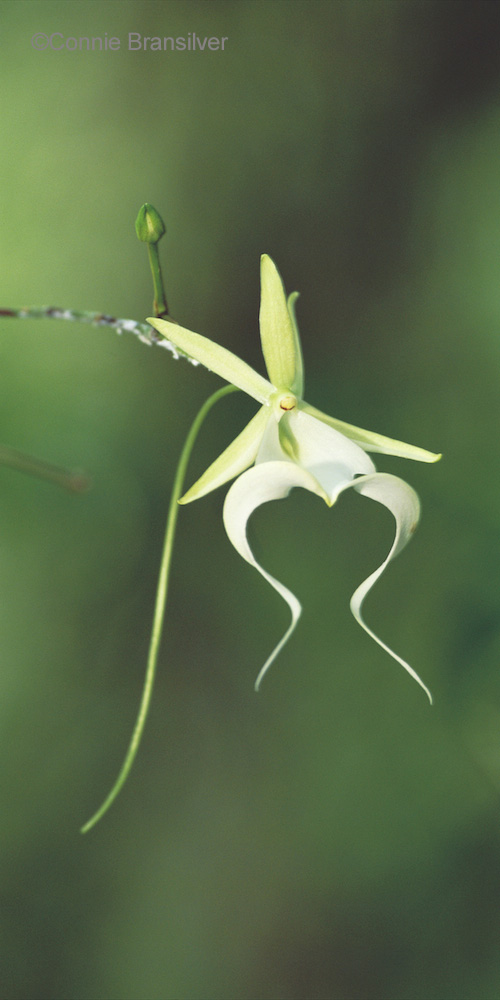Endangered Species
Endangered species photography from Connie Bransilver.























Gator, gator everywhere, yet these crocodilians from the Ice Age, while seeming numerous in the Florida swamps, are facing pressure from low water levels, decreasing habitat, and exotic species. So, what’s a poor gator to do when all the gator holes are taken by the big guys but find a nice back yard and a quick meal of pet poodle. And that, in short, is the problem with alligators and the alligators’ problem.
After Alaska, Florida hosts more Bald Eagles than any other state. Recently officially removed from the endangered species list after near extinction last century, the bird still struggles to find uncrowded habitat. We have a nesting pair near our home and on special mornings we can watch one or both fishing in Clam Bay.
It's the Habitat, Stupid! -- to rephrase a famous political truism. Like others -- orchids and panthers, storks and gopher tortoises -- it's habitat loss that's causing the decline of the colorful, quirky crested caracara in our ever more populous state. This relative of the falcon nests low in cabbage palms, making it vulnerable to predators, while agriculture, citrus groves tree plantations and housing swallow the grasslands they need. More immediate danger is along the busy roadways where they find carrion and hunt small animals.
This last pocket of the far-ranging puma east of the Mississippi, is considered a highly threatened subspecies. Actually, the panther population is doing fine except that there is not enough space for these cats so fights over territory and encounters with vehicles are taking a big toll. People are encroaching on panther swamp habitat, so they, in turn, are finding domesticated goats, poultry and dogs an easier catch than wild pigs and deer.
Gopher Tortoises provide housing for many other species, sharing their active and abandoned burrows in scrub hammocks, but they cannot effectively fight Developers. They want the same high ground, and despite being identified as a Keystone Species for their importance, they are increasingly being pushed aside for housing, strip malls and roads.
That means, in Latin, “wise man,” but how wise can we be if we so desecrate our own habitat that Mother Nature can no longer support us. Unless we listen, learn and act, our support system, the unique but precarious Everglades, will wither and die, and our precious children will be as much at risk as the Florida Panther.
The tree is not endangered. Though indigenous to the south Florida swamps, it is better known as the elegant frame of roads and up-market hotels of south Florida. Yet in the wooded swamps of the western Everglades, dominated by the Fakahatchee Strand, the majestic Royal Palm is increasingly hard to find.
Only the Florida and Cuban populations of Sandhill Crane are listed as endangered with only some 5,000 Florida Sandhill Crane individuals remaining. Being fairly social birds and tolerant of human habitation, they can often be seen in towns in central Florida as well as along roadways foraging for insects, small reptiles as well as berries and cultivated grains. Sightings in towns is evidence that their greatest threat is habitat destruction. Ground dwelling, their nests and chicks are vulnerable to foxes, raccoons, bobcats and other predators including farm machinery.
Indigenous to Florida, the curious, scrappy Scrub Jay is being crowded out of its home, sandy hammocks. Those slightly elevated and dry tracks are also prime development lands, so instead of nurturing Scrub Jay chicks, houses are springing up.
This gorgeous and gregarious wading bird of the ibis family is threatened by habitat loss. Roseate Spoonbills in flight or feeding in shallow waters are breathtaking. Like flamingos, their brilliant pink color is derived from their shrimp diet. Spoonbills used to be plentiful in Florida Bay, but after years of decline, they are returning and nesting. They also nest among the Wood Storks at Corkscrew Swamp Sanctuary.
Clear and fresh and teeming with fish -- Gambusia looking for yummy mosquito larvae, tiny crustaceans, all colored by leaf tannin -- Everglades swamp water is fed by rainfall and run off from Florida’s central spine. The natural slow flow of unpolluted water percolating through to the aquifers used by humans for drinking water is nature’s gift. We have messed with it, Man Taming the Swamp, but we have made a mighty mess. Now we realize Mother Nature was right all along. Our most endangered “species” is our water, and thus, us.
Sea turtles are among the oldest creatures on earth and have remained essentially unchanged for 110 million years. Now, we humans are threatening their very existence. Humans build on nesting beaches; humans pollute and throw trash into sea waters; humans drown them in fishing nets; and some humans still eat turtle eggs and meat. Watching turtle hatchlings struggle out of their nest on the beach and make their way to the water is an emotional experience. Everything from footprints to driftwood and crabs are obstacles, though this gauntlet strengthens them for survival. Hatchlings are vulnerable to birds, raccoons, and fish, too. Some experts say only one out of a thousand will survive to adulthood, but if they do, they always return to the beach of their birth to nest.
The small, endangered American breeding population of wood storks is finding the waters around its major rookery on the few remaining giant Bald Cypress at Corkscrew Swamp Sanctuary increasingly precarious. Waters have to be just right - not too high, not too low. In recent years, bountiful years for successful nesting have been interspersed with complete failures.
Endangered species photography from Connie Bransilver.